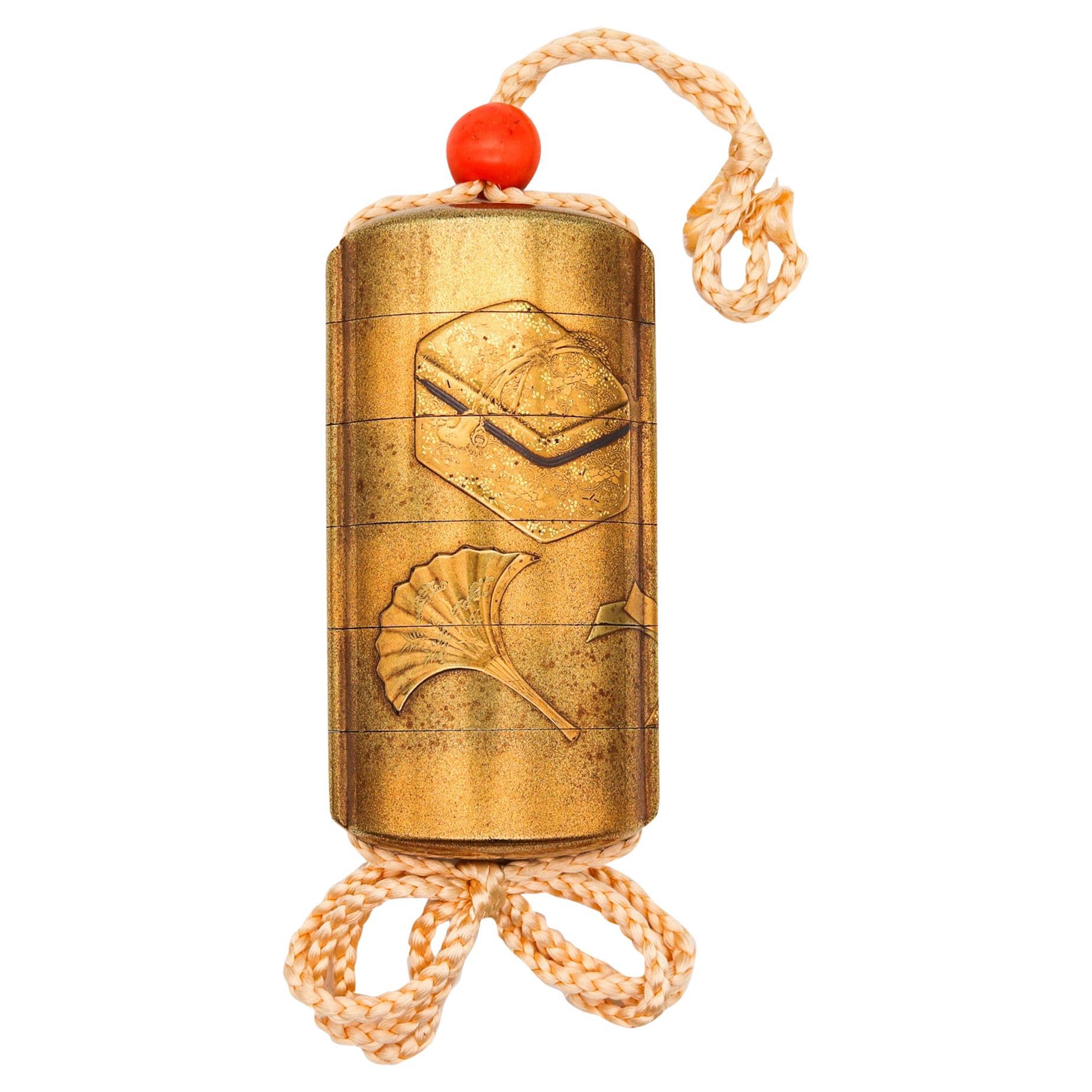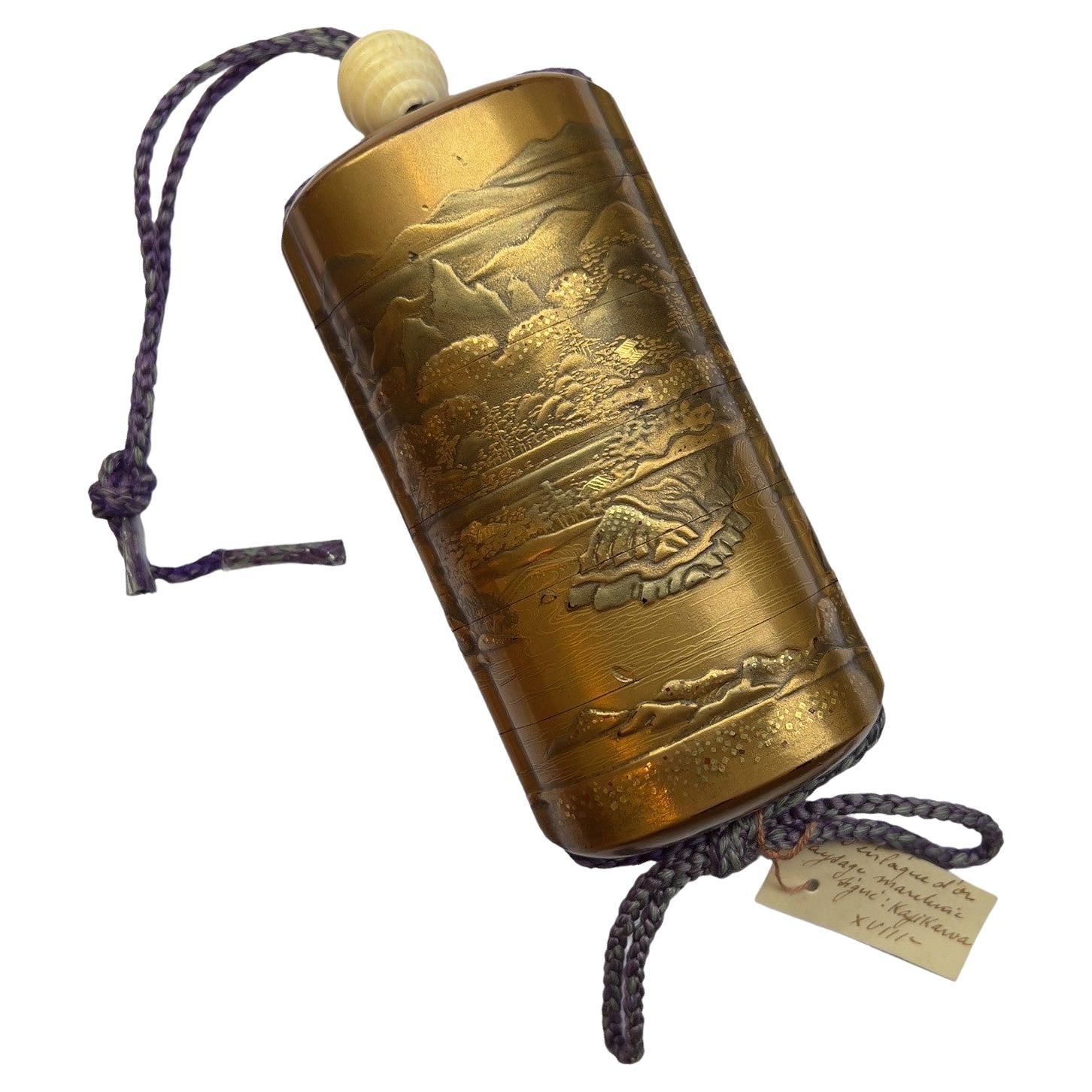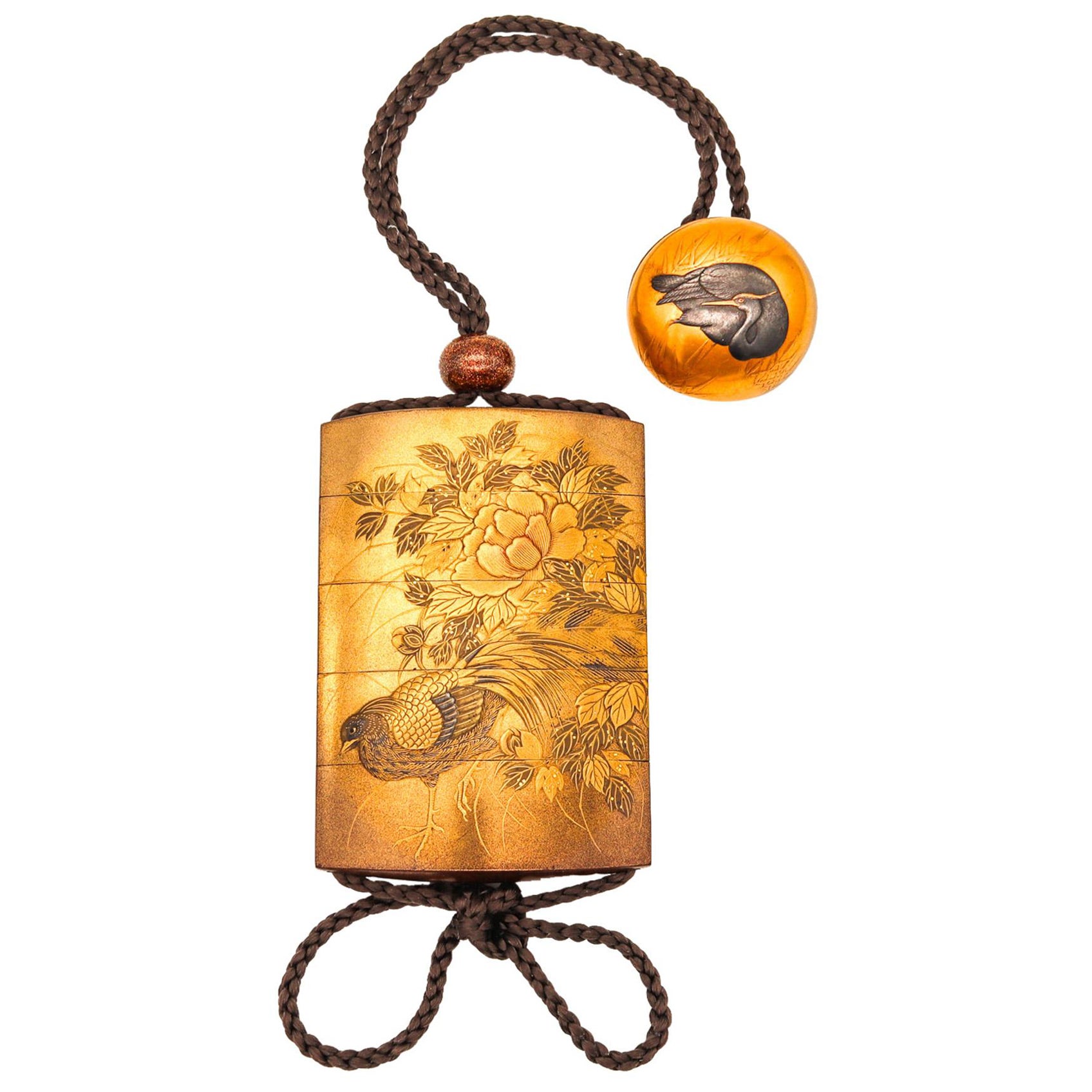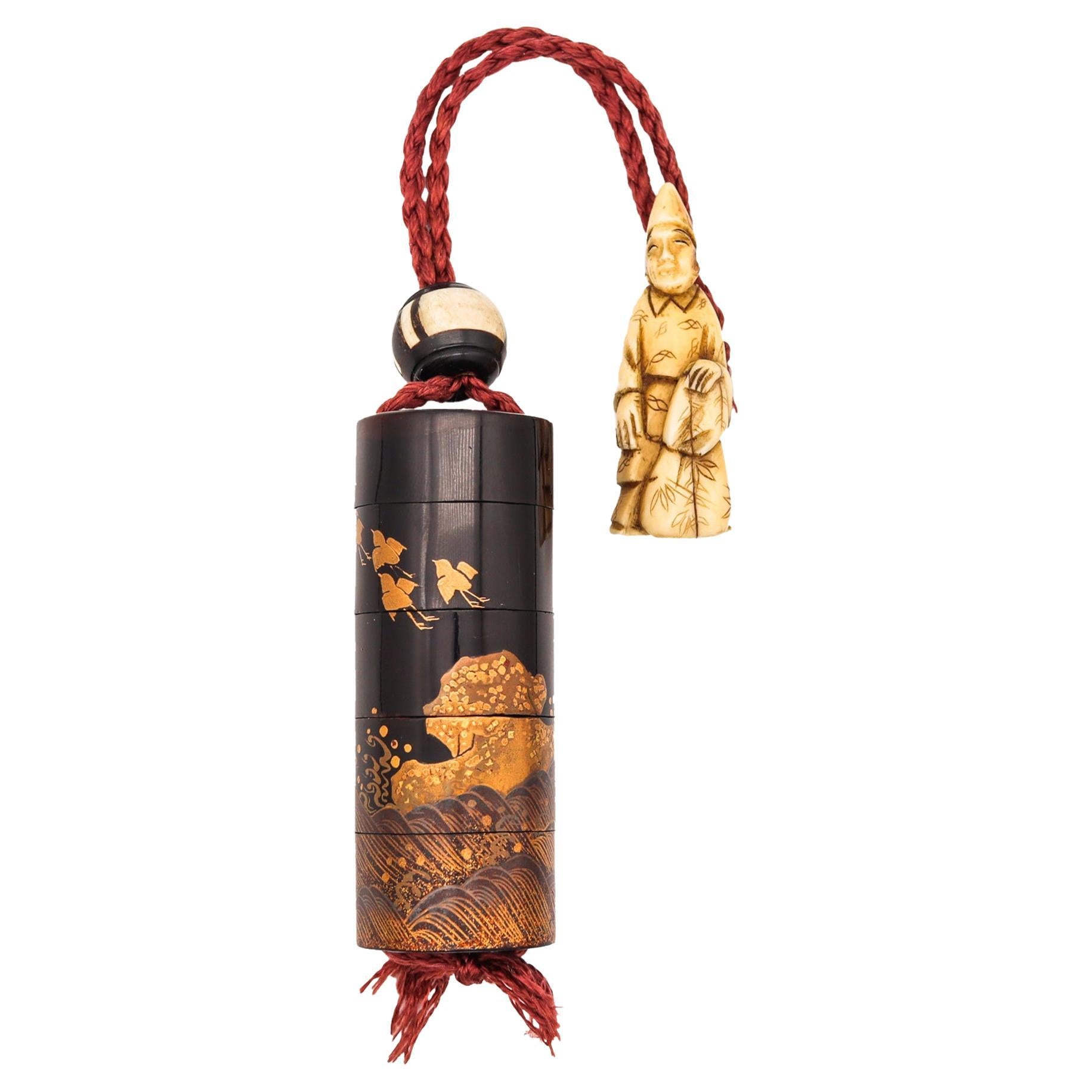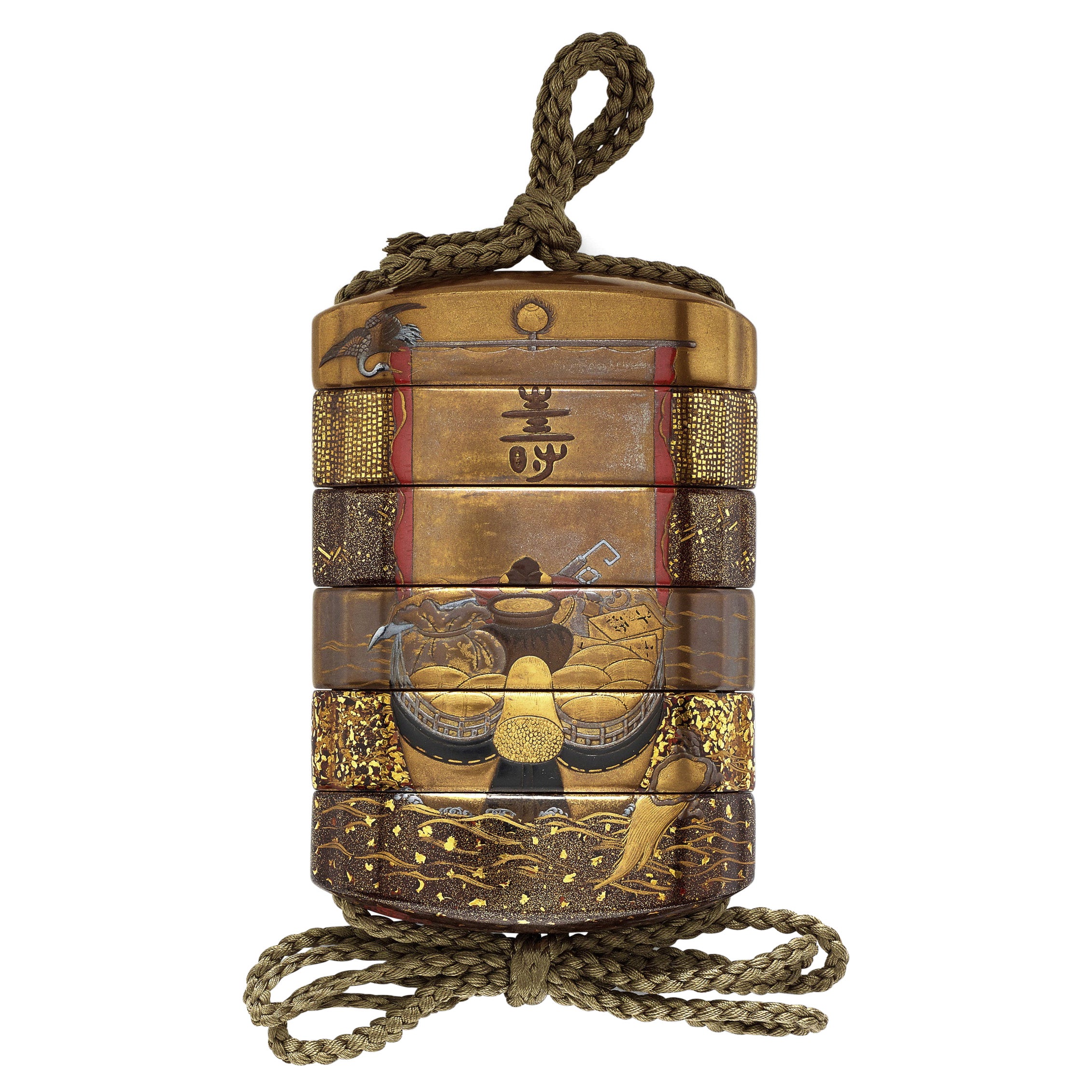Items Similar to Japan 1810 Kajikawa Edo Period Five Drawer Inro Lacquered Gilt Wood With Rooster
Want more images or videos?
Request additional images or videos from the seller
1 of 6
Japan 1810 Kajikawa Edo Period Five Drawer Inro Lacquered Gilt Wood With Rooster
About the Item
Japanese Inro from the Edo period (1615-1868) created by Kajikawa.
Beautiful Inro, created in Japan by one of the Kajikawa family during the Edo period (1615-1868), circa 1810. Has been carefully crafted in carved precious wood with applications of gilding maki-e and decorated with Japonism patterns. All dan trays are attached together with a himo cord. The detailed craftsmanship was a true pleasure to behold.
Period: Edo period (1615-1868). Shogunate.
Approximate Date: 1790-1810
Motif: A family of birds consisting of a cockerel, the hen and three chicks.
Drawers: Five.
Shape: Rectangular navette.
Technique: Carved wood, lacquer and decorated in iroe-hiramaki-e on a gold ground.
Ojime: 15mm 20mm, oval carved from natural translucent agate.
Netsuke: None
Weight: 47.70 Grams.
Measurements: Inro is 78 mm by 55 mm by 18 mm (3.07 x 2.17 x 0.71 Inches).
Signatures: Kajikawa Saku, in the underside with the signature KAJIKAWA. By a member of the Kajikawa family, signed Kajikawa 梶川 Japan, late 18th century to early 19th century, Edo period (1615-1868).
The Kajikawa family
Kajikawa family, flourished in the 19th century, they was Japanese lacquerware artists whose school in Edo (now Tokyo) flourished for more than 200 years. This family is perhaps the most famous of all the dynasties of Japanese lacquer artists, and certainly the name most often found on inro. The family is said to have been founded by Hikobei at Edo in the early 17th century, although some claim that the family’s great reputation really stemmed from his son and pupil Kyujiro. In any event, Hikobei worked for the shogunate, as did his successors until well into the 19th century. Kijirō excelled in designing particularly delicate lacquer inrō, portable medicine cases composed of a nest of tiny boxes tightly fitted into one another and secured with a silk cord. Because so much artistic skill went into decorating the outside of the inrō, they were worn on the obi (a broad sash) by men of the upper classes and were prized as collector’s items. Kajikawa artists also designed lacquer netsuke-toggles carved in the shapes of animals, human figures, and plants, used to attach medicine boxes and tobacco and money pouches to men’s sashes. Objects exemplifying the exquisite craftsmanship of the Kajikawa artists are in the Victoria and Albert Museum, London, and in the Charles A. Greenfield Collection, New York City. The Soken Kisho describes Kyujiro as ‘the best inro maker of the past or present’. See Earle, Joe [ed.] (1995) The Index of Inro Artists, p. 107.
The Edo Period
The Edo period or Tokugawa period is the period between 1603 and 1867 in the history of Japan, when Japan was under the rule of the Tokugawa shogunate and the country's 300 regional daimyo. Emerging from the chaos of the Sengoku period, the Edo period was characterized by economic growth, strict social order, isolationist foreign policies, a stable population, perpetual peace, and popular enjoyment of arts and culture. The period derives its name from Edo (now Tokyo), where on March 24, 1603, the shogunate was officially established by Tokugawa Ieyasu. The period came to an end with the Meiji Restoration and the Boshin War, which restored imperial rule to Japan. The Tokugawa (or Edo) period brought 250 years of stability to Japan. The political system evolved into what historians call bakuhan, a combination of the terms bakufu and han (domains) to describe the government and society of the period.[3] In the bakuhan, the shōgun had national authority and the daimyo had regional authority. This represented a new unity in the feudal structure, which featured an increasingly large bureaucracy to administer the mixture of centralized and decentralized authorities. The Tokugawa became more powerful during their first century of rule: land redistribution gave them nearly seven million koku, control of the most important cities, and a land assessment system reaping great revenues.
Inro
Is a traditional Japanese case for holding small objects, suspended from the obi (sash) worn around the waist when wearing a kimono. They are often highly decorated with various materials such as lacquer and various techniques such as maki-e, and are more decorative than other Japanese lacquerware. Because traditional Japanese dress lacked pockets, objects were often carried by hanging them from the obi in containers known as sagemono (a hanging object attached to a sash). Most sagemono were created for specialized contents, such as tobacco, pipes, writing brush and ink, but the type known as inro is suitable for carrying small things, and was created in the Sengoku period (1467–1615) as a portable identity seal and medicine container for travel. In the middle of the Edo period (1603–1868), inro became popular as men's accessories, and wealthy merchants of the chōnin and samurai classes collected inro often beautifully decorated with lacquer. As the technique developed from the late Edo period to the Meiji period (1868–1912) and the artistic value of inro increased, inro were no longer used as an accessory and came to be regarded as an art object for collection.
Ojime: An ojime (緒締め), lit. is a bead cord fastener used in Japanese inrō (carrying cases). It is typically under an inch in length. Each is carved into a particular shape and image, similar to the netsuke, though smaller.
Netsuke: A netsuke (根付, [netsɯ̥ke]) is a miniature sculpture, originating in 17th century in Japan. Initially a simply carved button fastener on the cords of an inrō box, netsuke later developed into ornately sculpted objects of craftsmanship.
Collateral: This piece is accompanied by a presentation pouch.
Condition: The overall condition of this Inro is excellent. Beside the little normal wear, there is no damage to any part. All part are original and secured. This piece has been carefully inspected to guarantee the condition and authenticity.
INVENTORY REF: D070523MTNE/.1111
- Dimensions:Height: 3.07 in (7.8 cm)Width: 2.17 in (5.52 cm)Depth: 0.71 in (1.81 cm)
- Style:Edo (Of the Period)
- Materials and Techniques:
- Place of Origin:
- Period:
- Date of Manufacture:1810
- Condition:Wear consistent with age and use. The overall condition of this Inro is excellent. Beside the little normal wear, there is no damage to any part. All part are original and secured. This piece has been carefully inspected to guarantee the condition and authenticity.
- Seller Location:Miami, FL
- Reference Number:
About the Seller
5.0
Platinum Seller
These expertly vetted sellers are 1stDibs' most experienced sellers and are rated highest by our customers.
1stDibs seller since 2023
63 sales on 1stDibs
Typical response time: <1 hour
- ShippingRetrieving quote...Ships From: Miami, FL
- Return PolicyA return for this item may be initiated within 1 day of delivery.
More From This SellerView All
- Japan 1800 Edo Period Six Drawer Inro In Lacquered Gilt Wood With UtensilsLocated in Miami, FLJapanese Inro from the Edo Period (1603-1867). Beautiful Inro, created in Japan during the Edo period (Shogunate), circa 1800. It was carefully crafted in carved precious wood with ...Category
Antique Early 1800s Japanese Edo Lacquer
MaterialsCoral
- Japan 18th Century Edo Period Five Drawer Inro Lacquered Gilt Wood With RoosterLocated in Miami, FLJapanese Inro from the Edo period (1615-1868) Beautiful Inro, created in Japan during the Edo (1615-1868) Shogunate period circa Late 18th century. It was carefully crafted in carve...Category
Antique 18th Century Japanese Edo Antiquities
MaterialsSilver
- Japan 1870 Meiji Period Round Five Drawer Inro Lacquered Wood With Flying CranesLocated in Miami, FLJapanese Inro from the Meiji Period (1868-1912). Beautiful Inro, created in Japan during the Meiji imperial period, circa 1870. It was carefully crafted in carved precious wood with...Category
Antique 1870s Japanese Meiji Lacquer
MaterialsGiltwood, Lacquer, Wood, Ebony
- Japan 1900 Meiji Miniature Hanagamidai Cabinet in Gilded Wood & Sterling SilverLocated in Miami, FLMiniature hanagamidai cabinet from the Japan meiji (1858-1912) period. Gorgeous and rare miniature drawers hanagamidai (cosmetic cabinet), created in the imperial Japan during the...Category
Antique Early 1900s Japanese Meiji Lacquer
MaterialsGold, Silver, Sterling Silver
- Japan 1890 Meiji Period Decorative Vase In Cloisonné Enamel With Wood BaseLocated in Miami, FLJapanese vase from the Meiji Period (1868-1912). Beautiful antique decorative vase, created in Japan during the Meiji period (1868-1912), circa 1890s. It was carefully crafted in so...Category
Antique 1890s Japanese Meiji Metalwork
MaterialsBronze, Enamel
- Japan 1890 Meiji Period Ebisu Sculpture in Wood Carving of an Old FishermanLocated in Miami, FLAn extremely well detailed wood carving of Ebisu, as a fisherman. Beautiful and well detailed sculpture, created in Japan during the Meiji dynastic period (1868-1912) back in the 1890's. This piece represent the god of good fortune Ebisu. Was exceptionally carved and executed from one solid single piece of rose wood, showing a gorgeous face expression, with intricate details in the hands and feets, he's carrying as usual a rod and a fish. Ebisu (yebisu), ???, god of fortune, the ocean and fisherman. In the japanese mythology is one of the seven gods of luck, sichi-fuku-jin, the patron of the fisherman and tradesmen. he is depicted as a bearded, smiling fisherman with formal long court ropes, often carrying a rod in one hand and a tai, symbolic fish of the good luck, in the other. The height is 14.25 inches (36.20 cm) and the base measurements is 6.5 by 6.45 inches (16.5 x 16.38 cm). Meiji period, is an era of Japanese history that extended from October 23, 1868 to July 30, 1912.The Meiji era was the first half of the Empire of Japan, when the Japanese people moved from being an isolated feudal society at risk of colonization by Western powers to the new paradigm of a modern, industrialized nation state and emergent great power, influenced by Western scientific, technological, philosophical, political, legal, and aesthetic ideas. As a result of such wholesale adoption of radically different ideas, the changes to Japan were profound, and affected its social structure, internal politics, economy, military, and foreign...Category
Antique 1890s Japanese Meiji Sculptures and Carvings
MaterialsWood
You May Also Like
- Japan, Late 18th Century Gold Lacquer Inro by Kajikawa, Edo PeriodLocated in PARIS, FRLate 18th century Inro by Kajikawa. Edo period Beautiful inro in gold lacquer representing a continuous landscape on both sides. The interior in Nashiji lacquer. Some small traces...Category
Antique 18th Century Japanese Lacquer
MaterialsLacquer
- Fine Japanese Lacquered Inro with Inlays by KajikawaLocated in Atlanta, GAA Japanese four-case lacquer inro by a member of Kajikawa family circa 19th century (late Edo to early Meiji period). It depicts a nocturnal scenery of a meandering stream surrounded by bush clovers, where a full moon is reflected on the water. It was masterfully decorated in gold and silver maki-e using a combination of techniques including takamakie, togidashi and kirigane as well as aogai (abalone shell) inlays. The stream was set between the slightly elevated banks, adding to this piece a already strong three-dimensional composition. The interior was decorated in gold nashiji. It was signed on the bottom "Kajikawa Zou" (made by Kajikawa and a pot seal centered with "Ei" in Kanji. In one of the compartment, there is a katakana mark, appears to be a name, possibly the owner. Kajikawa clan was one of the most famous lacquer artisanal family established in the 17th century. Many well known members over the generations produced lacquer art in a wide range of formats, but two third were signed only with the family name such as this one. It is therefore not possible to pinpoint the exact author of this piece. Provenance: This inro was purchased as lot 349 in Christie's New York sale Japanese...Category
Antique 19th Century Japanese Japonisme Lacquer
MaterialsWood, Lacquer, Shell
- Five-Case Inrō 19th Century Signed Kajikawa Saku Japanese Lacquer BoxLocated in Milano, ITSigned: “Kajikawa saku” and with a red pot seal Height: 3 1/8in (7.9cm) Provenance: Michael Tomkinson Collection Leonard Haber Collection Literature: Michael Tomkinson, A Japanese Collection, London: George Allen, 1898, no. 300 Each case with slightly recessed joints and with different grounds, including kinji, nashiji, togidashi maki-e and gyobu-nashiji, on the obverse decorated with a treasure ship laden with the attributes of the Seven Gods...Category
Antique 19th Century Japanese Lacquer
MaterialsWood, Lacquer
- Japanese Meiji Period Lacquer Six Drawer InroLocated in Newark, EnglandThe Inro is decorated with a gold lacquer base and features mother of pearl shell inlay leaves surounding wheeled cart with foliage. The Inro with a slide action opening which hides ...Category
Antique Late 19th Century Japanese Meiji Lacquer
MaterialsRope, Lacquer
- Rare Japanese Sumi-E Lacquer Inro Yamada Jokasai Edo PeriodLocated in Atlanta, GAA three-case lacquered Inro by Yamada Family circa 18th-19th century Edo period. The inro with slight rounded form is of Kano style and vividly depicts a dragon slithering among the ink clouds on a gold background. Sumi-e togidashi (ink togidashi) technique, in combination with Hiramaki-e, were employed to create the dreamy ambience of this piece. The dragon has a painterly appearance inspired by Chinese ink painting that was often seen on the Japanese folding screens. The back of the Inro was sparsely decorated with the shifting patterns of the darkening clouds with an emphasis on the space intentionally left empty. Jokasai was signed to the base. On the front of the inro there is another miniature signature Hakugyoku Hogen, which is one of names used by Kano Michinobu (1730-1790). The dragon is evidently one of his designs (see reference below). Established by a member of Yamada family in the 17th century, the clan was one of the most prominent lacquer artisanal family for the next 200 years until the end of Edo period in the 19th century. Most members signed their work simply with Jokasai making the identification of the individual artists somewhat impossible. The current Inro on offer, compared to many other pieces by Jokasai, has an uncommon Kano style done in Sumi-e togidashi. Another unusual feature of this piece is that the interiors of the inro was decorated with an interesting gold mosaic inlays (kirigane) on a dark lacquer background, giving it a jewel like quality. For another Inro by Jokasai of a similar style using Sumi-e togidashi but depicts a tiger, see Wrangham collection, no.353, which was offered for sale as lot 256 in Bonham's London Auction: The Edward Wrangham Collection of Japanese Art Part I. 9 Nov 2010. For an ink scroll...Category
Antique 18th Century Japanese Japonisme Lacquer
MaterialsWood, Lacquer
- Antique Japanese Inro by Shigehide Edo PeriodLocated in Atlanta, GAThis exquisite four-case lacquered inro was dated to the latter part of 18th century to early 19th century (Edo period) and made by Shigehide. The opposite sides of the inro together features a lavish flower arrangement in a bamboo basket (ikebana). The detailed craftmanship was a true pleasure to behold. Mostly Takamaki-e (high relief) were used to texturize the delicate petals of the chrysanthemums, on which different shades of gold were used to create contrast. Raden (mother of pearl) shells were also used to highlight some leaves, rendering the piece an interesting balance of color and material. The interior was completed in a mottled gold finish. It was signed Shigehide on the bottom with a Kao. There is a small carved rabbit ojime bead...Category
Antique Late 18th Century Japanese Japonisme Lacquer
MaterialsWood, Lacquer
Recently Viewed
View AllMore Ways To Browse
Indian Wood Angels
Japanese Tanzaku
Negoro Tray
Stacking Lunch Box
Hasami Bako
Lacquer Hsunok
Suzuki Silver
African Wand
Japanese Hokkai Box
Midcentury Black Lacquer Inlay Wall Art
Peranakan Mirror
Rabbit Netsuke Ojime
Sake Storage Container
Tetsuya Yamada
Japanese Lacquer Pearl
Antique Asian Food Box
Japanese Sake Set Antique
Chinese Red Cinnabar Box
